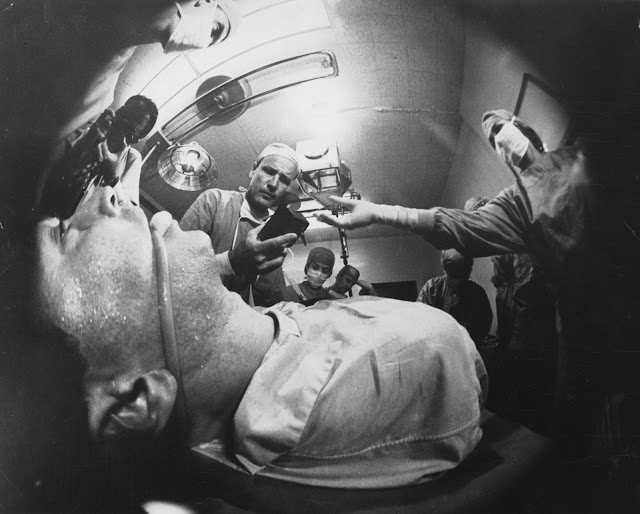It would appear that a bizarre cinema pertaining to face transplants and extreme plastic surgery has developed in international film community over the last fifty years. For the most part they are an unlikely amalgamation of cinematic styles as seemingly disparate as suburban psychodrama, science fiction art house cinema, midlife crisis film, etc. It is a small but persistent genre consisting of relatively few films. A list of the more archetypal/obvious films follows. Unsurprisingly, the most recent film in this list hails from South Korea, famous cinematically for mixed genres and abrupt changes in tone from scene to scene, as well as for its plastic surgery obsessed youth culture.
· Dark Passage (dir. Delmer Daves, 1947, USA)
· Eyes Without a Face (dir. Georges Franju, 1960, France)
· Seconds (dir. John Frankenheimer, 1966, USA)
· The Face of Another (dir. Hiroshi Teshigahara, 1966, Japan)
· Face/Off (dir. John Woo, 1997, USA)
· Time (dir. Kim-Ki Duk, 2007, S. Korea)
Seconds was my introduction to the genre, so I will discuss that briefly, and then discuss the implications of the genre's persistence in the international film community. The first act of the film is primarily concerned with establishing Arthur’s suffocating, claustrophobic existence, emphasized through the technique of upward angles upon upward angles, and close ups that put us in such proximity to our subjects’ faces that we are made uneasy. Arthur is contacted by a mysterious company and given the chance at a new life with a new face. Although he is initially apprehensive at the moral consequences of abandoning his family and other obligations, Arthur is ultimately willing to do this for the opportunity of a new identity.
At the end of the second act of the film, Arthur (now Tony) finds himself at a harvest festival. He finds himself unwillingly stripped and dumped into a grape-crushing vat filled with beatniks. Here, we see Arthur transcend his identity expressed in the form of increasingly ecstatic editing of writhing bodies, stomping feet, faces, bodies, and light peeking through the branches and vines until we the viewer become entangled in the seething mass. Arthur has finally let go of himself, losing himself in the crowd.
Transcendence of ego serves as a goal for many religious/spiritual/occult practices. It is widely acknowledged that transcendental meditation becomes increasingly effective in large groups, where people can feed off of one another’s energy. Arthur gets a brief glimpse of this pure consciousness, as a part of the seething mass of hippies, but after the moment, it is gone, and Arthur finds himself trapped again, by the cage of his new created identity.
It seems that this willingness, or even eagerness, to shed one’s identity ties in with one of the most common clichés in cinema, which is the idea of “Let’s run away and start all over again.” This is ultimately what our protagonist’s decision amounts to: escaping from himself in hopes that the new beginning will provide a fresh start with no burdens of past guilt or obligation. As viewers, we see that this is naïve, as obviously this decision is what ultimately seals these characters’ respective fates. This is interesting, because it holds up a mirror to the audience, who are also attempting an escape from reality, if only for the short duration of the film. It would seem that there are parallels to this act in the act of losing connection with one’s appearance through plastic surgery (one’s face is intimately connected to identity).
Surges in popularity of cinema at times of financial instability are a testament to cinema’s great potential as a means of escaping the drudgery of day-to-day existence. Bertrand Russell suggests that as a society, we have tried to divorce ourselves from our animal instincts, and thusly we have a spiritual void that we hopelessly try to fill with pale mimicries of primitive human behavior. Perhaps some or all of this factors in to the existence and persistence of this cinema across genre and cultural boundaries.
The face transplant theme, which pops up over and over again, albeit rarely, reflects all of this. This theme became of particular interest to me after watching Delmer Daves’ Dark Passage in close succession with Seconds. In Daves’ film, Bogart makes a statement (after his own dramatic plastic surgery, and a whole new set of problems), that he just wants to get away “To somewhere nobody knows my face.” This captures, in essence, the nature of this strange cinema. We want to run away, and in so doing, just create new things for ourselves to run away from. After all, it would appear that we, and all of these characters, are really just trying to escape from ourselves.

Note, this is NOT the originally promised 8 page behemoth. A pdf of the full paper is available to curious parties. This is a shorter version submitted for publication consideration to a student magazine. I felt like this version seemed a little more blog-appropriate in terms of size, and the fact that it is more generally focused. The longer version is a little bit rambling at times, but also touches on areas that this smaller paper can not. In particular, I analyze the grape-crushing sequence in Seconds, which, while being largely ignored in the existing writing on the film, uses interesting techniques to show dissolution of ego, and is interesting piece of exposition in the film.
ReplyDelete